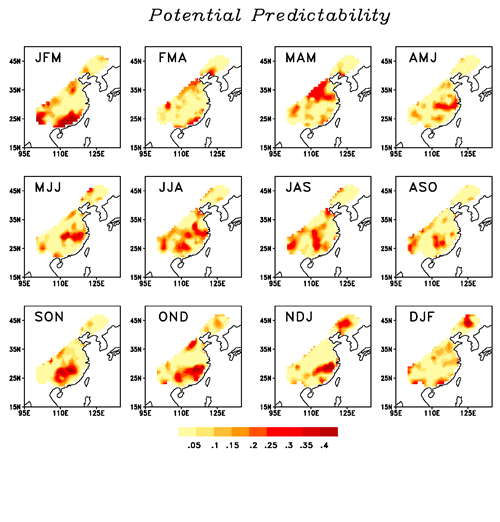Identifying the Predictable Signals of Seasonal Precipitation in Eastern China
Date:2016-07-04
As an area strongly influenced by the East Asian Monsoon (EAM), eastern China is characterized by large precipitation variability with complex spatial and temporal structures. The factors governing the interannual variability of seasonal mean precipitation in eastern China are many and varied, as indicated by many previous studies. Besides the internal dynamics of the monsoonal circulation, external forcing factors such as global sea surface temperatures (SSTs), Tibetan Plateau heating, Eurasian snow cover, and polar ice coverage, are known to be influential in terms of the variability of eastern China precipitation. The intraseasonal oscillation in the broad period range from 10 to 60 days has been considered as another important factor affecting the EAM and the monsoonal precipitation over eastern China. In contrast to the slowly varying impact of SSTs, the intraseasonal component of the interannual variability of seasonal mean fields is essentially unpredictable beyond a season.
So, when focusing on the issue of seasonal forecasting of seasonal mean precipitation over eastern China, the impact of intraseasonal variability is considered as unpredictable noise. The primary question we ask is how the potential predictability may be estimated by removing the “intraseasonal noise” from the interannual variability of seasonal means of eastern China precipitation? Another issue is to investigate the sources of predictability as well as the uncertainty in prediction of the seasonal precipitation.
Recently, Dr. YING Kairan and Dr. ZHAO Tianbao from Institute of Atmospheric Physics, Chinese Academy of Sciences, and their colleagues examined the patterns of interannual variability that arise from the slow (potentially predictable) and fast or intraseasonal (unpredictable) components of seasonal mean precipitation over eastern China, using a variance decomposition method, based on observations from a network of 106 stations for the period 1951-2004.

Fig.1 Spatial distributions of the potential predictability of seasonal precipitation over eastern China for the consecutive three-month periods from JFM to DJF during the period 1951-2004 (Ying et al., 2016)
They found the average potential predictability (ratio of slow-to-total variance) of eastern China precipitation is generally moderate, with the spatial pattern shown in Fig.1. The leading predictable precipitation mode is significantly related to one-season-lead SST anomalies in the area of the Kuroshio Current during April-March-June (AMJ) to June-July-AugustJJA, the Indian-western Pacific SST in July-August-September (JAS), and the eastern tropical Pacific SST from September-October-November (SON) to the following March-April-May (MAM). The prolonged linear trends, which are seen in the principal component time series associated with the second or third predictable precipitation modes in MJJ-to-ASO, also serve as a source of predictability for seasonal precipitation over eastern China. The predictive characteristics of the atmospheric circulation-precipitation relationship indicate that the western Pacific subtropical high plays a key role in eastern China precipitation. In addition, teleconnection patterns that are significantly related to the predictable precipitation component are also identified.
As the interannual variability of rainfall in eastern China is mainly related to the intraseasonal (or unpredictable) component, they also investigated the intraseasonal modes of the seasonal precipitation in eastern China and their associated atmospheric circulations. The leading/second unpredictable precipitation modes from MAM to SON all show a monopole/dipole structure, which are accompanied by wavy circulation patterns that are related to intraseasonal events.
In addition, they found the ENSO signal in the fall seasonal precipitation persisted throughout the period 1951-2004 while the signal in winter and spring intensified significantly after the mid-1970s. Further examination found the significant interdecadal change maybe attributed to an increased intensity of ENSO, and more vigorous atmospheric responses including an intensified variabilities in the tropical Hadley Cell circulation and the western Pacific subtropical high, larger ENSO signal in the winter rainfall in east China and the strengthened covariance between the atmospheric circulation and the rainfall variabilities.
References
1)Ying, K., T. Zhao, X.-W. Quan, X. Zheng, C. S. Frederiksen, 2015: Interannual variability of autumn to spring seasonal precipitation in eastern China, Climate Dynamics,45, 253-271, doi:10.1007/s00382-014-2411-2.
http://link.springer.com/article/10.1007/s00382-014-2411-2
2) Ying, K., X. Zheng, T. Zhao, C. S. Frederiksen, X.-W. Quan, 2016: Identifying the predictable and unpredictable patterns of spring-to-autumn precipitation over eastern China, Climate Dynamics, doi: 10.1007/s00382-016-3258-5.
http://link.springer.com/article/10.1007/s00382-016-3258-5
Contact:
YING Kairan, yingkr@tea.ac.cn
